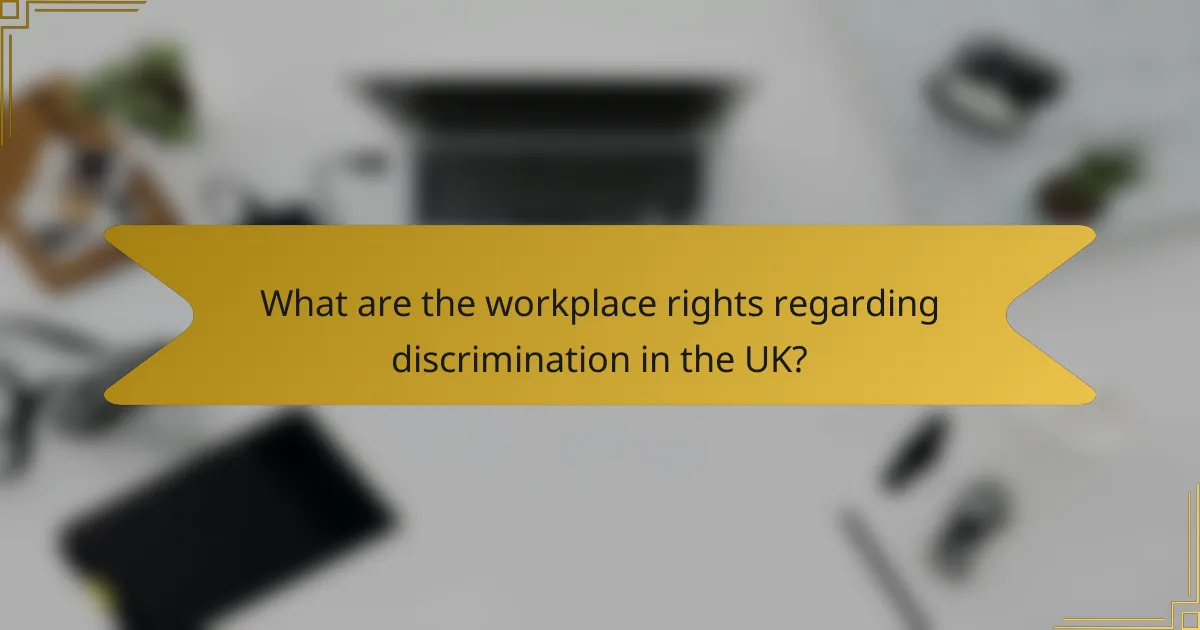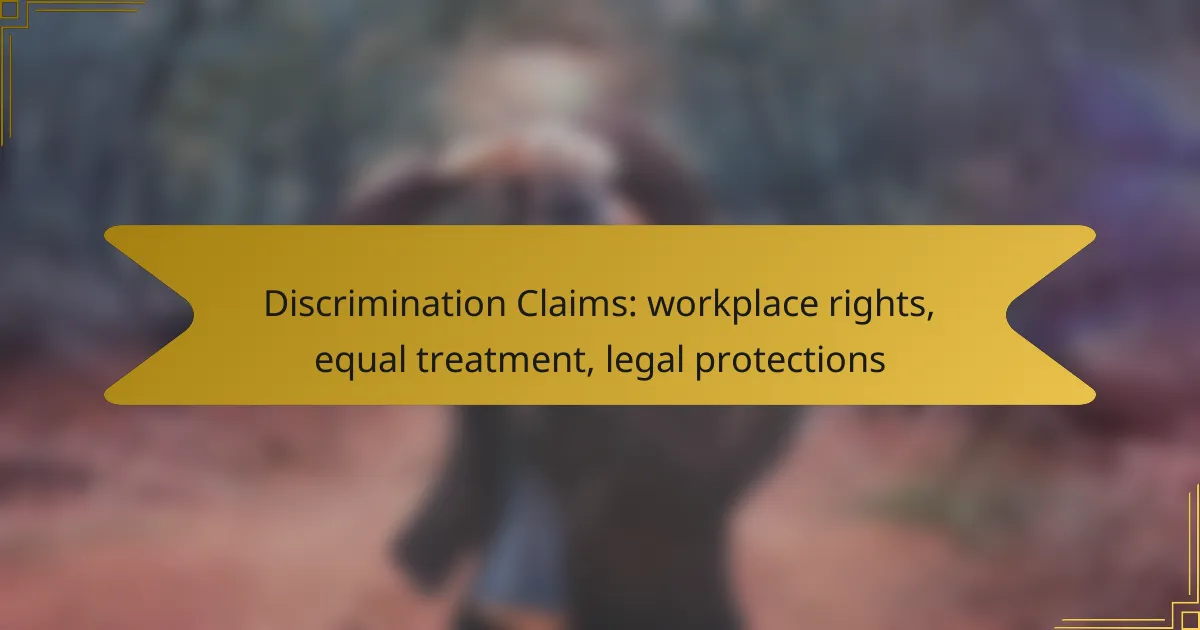In the UK, employees are safeguarded by laws that promote equal treatment and prohibit discrimination based on characteristics such as race, gender, age, or disability. The Equality Act 2010 and the Employment Rights Act 1996 are pivotal in ensuring workplace rights, allowing individuals to seek remedies for unfair treatment. Understanding the procedures for addressing discrimination claims empowers employees to advocate for their rights effectively.

What are the workplace rights regarding discrimination in the UK?
In the UK, workplace rights regarding discrimination ensure that employees are treated fairly and equally, regardless of characteristics like race, gender, age, or disability. These rights are protected under various laws, including the Equality Act 2010, which prohibits discrimination and promotes equality in the workplace.
Protection against unfair treatment
Employees in the UK are protected from unfair treatment based on specific characteristics, known as “protected characteristics.” These include age, disability, gender reassignment, race, religion or belief, sex, and sexual orientation. Employers must ensure that their policies and practices do not discriminate against individuals with these characteristics.
For example, if an employee is overlooked for promotion solely due to their age or gender, this could be considered unfair treatment. Employers are required to provide equal opportunities and create a workplace environment free from discrimination.
Right to file a complaint
Employees have the right to file a complaint if they believe they have been discriminated against at work. This process typically begins with raising the issue internally through the company’s grievance procedure. If the matter is not resolved satisfactorily, employees can escalate their complaints to external bodies such as the Employment Tribunal.
It is advisable for employees to document any incidents of discrimination, including dates, times, and witnesses, to support their claims. Timely action is crucial, as there are strict time limits for filing complaints, usually within three months of the incident.
Access to legal support
Employees facing discrimination in the workplace can access various forms of legal support. Organizations such as the Citizens Advice Bureau provide free advice on employment rights and can assist individuals in understanding their options. Additionally, solicitors specializing in employment law can offer tailored legal guidance.
It is important for employees to seek legal advice early in the process, especially if they are considering taking their case to an Employment Tribunal. Legal professionals can help navigate the complexities of discrimination claims and ensure that employees’ rights are upheld effectively.

How can employees address discrimination claims?
Employees can address discrimination claims by following established procedures within their workplace, seeking mediation, or pursuing legal action if necessary. Understanding these options helps ensure that employees can effectively advocate for their rights and seek fair treatment.
Reporting procedures
To initiate a discrimination claim, employees should first report the issue to their supervisor or human resources department. Most organizations have specific protocols in place to handle such complaints, which may include filling out a formal complaint form or participating in an initial meeting.
It is crucial to document all incidents related to the discrimination, including dates, times, witnesses, and any communications. This information can strengthen your case and provide clarity during the investigation process.
Mediation options
Mediation can be a valuable step in resolving discrimination claims without escalating to legal action. Many employers offer mediation services, where a neutral third party helps facilitate a discussion between the employee and the employer to reach a mutually agreeable solution.
Consider whether mediation is appropriate for your situation. It can be a quicker and less adversarial option than litigation, but it may not be suitable if the discrimination is severe or if you seek formal accountability.
Legal action steps
If internal reporting and mediation do not resolve the issue, employees may consider legal action. The first step is often to file a complaint with a relevant government agency, such as the Equal Employment Opportunity Commission (EEOC) in the United States, which investigates discrimination claims.
After receiving a “right to sue” letter from the agency, employees can then file a lawsuit in court. It’s advisable to consult with an attorney who specializes in employment law to navigate the complexities of legal proceedings and to understand potential outcomes and costs involved.

What legal protections exist for employees in the UK?
In the UK, employees are protected by various laws that ensure equal treatment and prohibit discrimination in the workplace. Key legislation includes the Equality Act 2010 and the Employment Rights Act 1996, which provide comprehensive rights and remedies for employees facing discrimination or unfair treatment.
Equality Act 2010
The Equality Act 2010 consolidates and simplifies previous anti-discrimination laws in the UK. It protects employees from discrimination based on protected characteristics such as age, gender, race, disability, sexual orientation, and religion.
Under this act, employers must ensure equal treatment in hiring, promotions, and working conditions. Employees who believe they have been discriminated against can file a claim with an employment tribunal, which can lead to compensation or other remedies.
Employment Rights Act 1996
The Employment Rights Act 1996 provides employees with essential rights regarding their employment contracts, including protection against unfair dismissal and the right to receive a written statement of employment particulars. This act ensures that employees cannot be dismissed for discriminatory reasons.
Employees can seek recourse if they believe their rights under this act have been violated, often through an employment tribunal. It’s crucial for employees to understand their rights and the procedures for making a claim if they face unfair treatment.
Protection from harassment
Employees in the UK are protected from harassment in the workplace under the Equality Act 2010. Harassment is defined as unwanted behavior related to a protected characteristic that violates a person’s dignity or creates a hostile environment.
Employers have a legal obligation to prevent harassment and take appropriate action if it occurs. Employees should report any incidents to their employer or HR department, and if necessary, they can pursue legal action through an employment tribunal for damages or other remedies.

What are the common types of discrimination in the workplace?
Common types of workplace discrimination include age, gender, and disability discrimination. These forms of bias can significantly impact employees’ rights and opportunities, leading to unequal treatment and legal challenges.
Age discrimination
Age discrimination occurs when an employee is treated unfairly because of their age, typically affecting those over 40. This can manifest in hiring practices, promotions, or layoffs, where older workers may be overlooked in favor of younger candidates.
To combat age discrimination, employees should document instances of biased treatment and familiarize themselves with the Age Discrimination in Employment Act (ADEA), which protects workers in the United States. Employers should ensure their policies promote inclusivity and equal opportunity for all age groups.
Gender discrimination
Gender discrimination involves treating an employee unfavorably due to their gender, which can affect hiring, pay, and job assignments. This form of discrimination can impact both men and women, but women often face more significant challenges in terms of pay equity and advancement opportunities.
To address gender discrimination, employees should be aware of the Equal Pay Act and Title VII of the Civil Rights Act, which prohibit such practices. Organizations should conduct regular pay audits and implement training programs to foster a more equitable workplace.
Disability discrimination
Disability discrimination occurs when individuals with disabilities are treated unfairly in the workplace. This can include a lack of reasonable accommodations, unfair hiring practices, or hostile work environments that do not support individuals with disabilities.
Employees facing disability discrimination should understand their rights under the Americans with Disabilities Act (ADA) and document any incidents of discrimination. Employers are encouraged to create inclusive policies and provide necessary accommodations to support all employees effectively.

What evidence is needed for a discrimination claim?
To support a discrimination claim, individuals typically need to gather specific evidence that demonstrates unfair treatment based on protected characteristics. This evidence can include documentation of incidents, witness statements, and correspondence records that collectively illustrate the discriminatory behavior.
Documentation of incidents
Documentation of incidents is crucial for substantiating a discrimination claim. This can include detailed notes about specific events, dates, times, and the individuals involved. Keeping a consistent record helps establish a timeline and context for the alleged discrimination.
Examples of documentation may include performance reviews, disciplinary actions, or any written communication that reflects discriminatory remarks or decisions. Aim to collect evidence over a period to show a pattern of behavior, if applicable.
Witness statements
Witness statements can significantly bolster a discrimination claim by providing third-party perspectives on the incidents. Colleagues who observed the discriminatory behavior can offer valuable testimonies that corroborate your experiences. Their accounts can help validate your claims and add credibility to your case.
When seeking witness statements, approach individuals who are willing to support your claim and ask them to document their observations in writing. Ensure their statements are clear, factual, and include relevant details about what they witnessed.
Correspondence records
Correspondence records, such as emails, memos, or text messages, can serve as critical evidence in a discrimination claim. These records may contain discriminatory comments or illustrate a pattern of biased communication from supervisors or colleagues. Collecting this correspondence can help establish a direct link between the behavior and the discrimination claim.
Be sure to save all relevant communications and organize them chronologically. Highlight any instances where discriminatory language or actions were evident, as this can strengthen your case significantly.

What are the potential outcomes of a discrimination claim?
The potential outcomes of a discrimination claim can vary widely, but they often include financial compensation, job reinstatement, or changes to workplace policies. These outcomes aim to address the harm caused by discrimination and prevent future occurrences.
Compensation for damages
Compensation for damages typically involves monetary awards to the claimant for losses incurred due to discrimination. This can include lost wages, emotional distress, and legal fees. The amount awarded can vary significantly based on the severity of the discrimination and the specific circumstances of the case.
In the U.S., for example, damages can range from thousands to millions of dollars, depending on the case’s complexity and the jurisdiction. Claimants should document all relevant financial impacts to strengthen their case for compensation.
Reinstatement or promotion
Reinstatement or promotion is another possible outcome of a discrimination claim, particularly if the claimant was unfairly terminated or denied advancement opportunities. Courts or settlement agreements may require the employer to reinstate the employee to their previous position or provide a promotion that was unjustly withheld.
This outcome not only aims to rectify the individual’s situation but also serves as a reminder for organizations to uphold fair treatment in their employment practices. Employees should be prepared to discuss their qualifications and contributions to support their case for reinstatement or promotion.
Policy changes within the organization
Policy changes within the organization can be a crucial outcome of discrimination claims, as they help prevent future incidents. Employers may be required to implement new training programs, revise existing policies, or establish clearer reporting mechanisms for discrimination complaints.
Such changes benefit not only the claimant but also create a more equitable workplace for all employees. Organizations should actively engage in regular reviews of their policies to ensure they align with legal standards and promote a culture of inclusivity.
